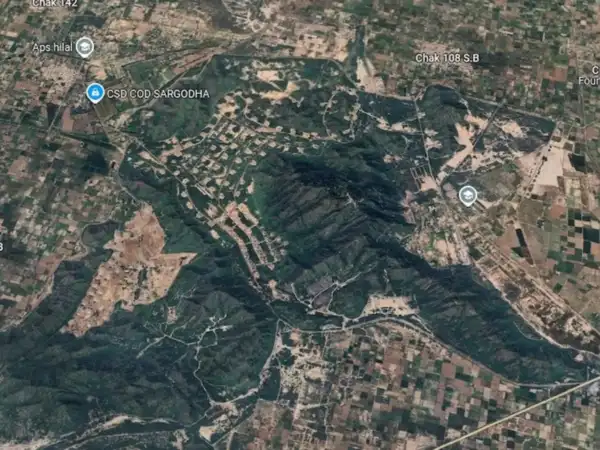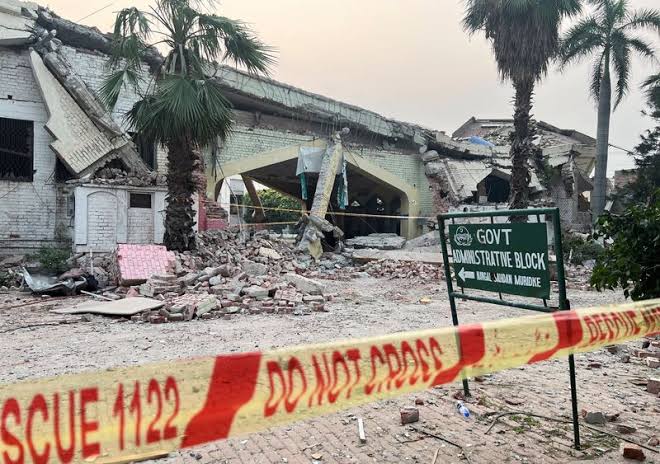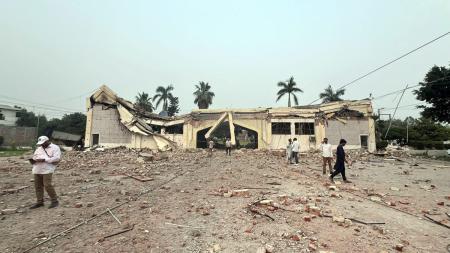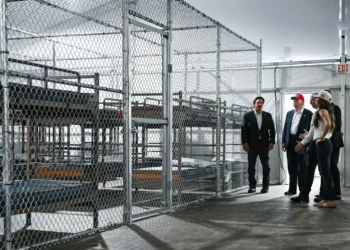In recent days, a series of earthquakes has struck Pakistan, sparking widespread speculation about the possibility of secret nuclear tests.
The country experienced three significant earthquakes within a span of just three days. The most recent quake, with a magnitude of 4.6, occurred near Pir Jongal, Punjab, at 1:26 PM IST. According to the National Center for Seismology (NCS), the epicenter was located near a known fault line.

The earthquakes, which included a 4.7 magnitude quake and a 4.0 magnitude tremor on May 10, have raised concerns and fueled theories about a potential link between the seismic activity and nuclear testing.
Key Takeaways
- Three significant earthquakes struck Pakistan within three days.
- The latest quake had a magnitude of 4.6 and occurred near Pir Jongal, Punjab.
- The National Center for Seismology confirmed the epicenter was near a known fault line.
- The earthquakes have sparked speculation about possible secret nuclear tests.
- The seismic activity has raised concerns and fueled theories about a potential link between the earthquakes and nuclear testing.




Recent Seismic Activity in Pakistan: The Facts
A trio of earthquakes has struck Pakistan in a matter of days, with the latest quake registering a magnitude of 4.6 on the Richter scale. This series of seismic events has raised concerns and sparked speculation about the causes. To understand the situation better, it’s essential to look at the facts surrounding these earthquakes.
Timeline of Three Consecutive Earthquakes
The sequence of earthquakes began on Saturday with a 5.7-magnitude quake, followed by a 4.0-magnitude tremor later that day. The latest earthquake, with a magnitude of 4.6, struck near Pir Jongal, Punjab, at 1:26 PM IST on Monday.
Latest Quake: 4.6 Magnitude Near Pir Jongal, Punjab
The National Center for Seismology (NCS) reported that the latest quake had a magnitude of 4.6. The epicenter was located near Pir Jongal, Punjab. This information is crucial as it helps in understanding the seismic activity in the region.
National Center for Seismology Findings
The NCS confirmed that the epicenter of the latest quake was near a known fault line. This finding is significant as it provides insight into the cause of the earthquakes.
Confirmation of Natural Fault Line Activity
The NCS findings suggest that the recent earthquakes are a result of natural fault line activity. According to the NCS report, the earthquakes were not caused by any artificial seismic activity, such as nuclear tests. As stated by the NCS,
“The earthquakes were a result of natural tectonic plate movements.”
Social Media Erupts with Nuclear Test Theories
As news of the consecutive earthquakes in Pakistan spread, social media platforms became rife with theories suggesting a connection to covert nuclear testing. The speculation was fueled by the frequency and proximity of the earthquakes, leading many to speculate about a possible link to nuclear activities.
The claims on social media ranged from assertions that the earthquakes were caused by nuclear tests to more nuanced arguments suggesting that the seismic activity was somehow related to Pakistan’s nuclear program. A user on a popular social media platform claimed, “Based on geolocation, the above video of a strike on Pakistan’s nuclear weapons storage facility in Kirana Hills is accurate. The tunnel entrance was struck in a precise hit, and the impact of the blast caused an earthquake registered on a 4.0 Richter scale,” (posted on May 12).
Viral Claims Linking Earthquakes to Covert Testing
Viral claims on social media often cited unverified videos and images purporting to show the effects of nuclear tests. These claims were frequently accompanied by assertions that the earthquakes were not natural but were instead triggered by human activity, specifically nuclear testing.
The spread of such claims was rapid, with many users sharing the content without verifying its accuracy. This highlights the challenge of managing misinformation on social media platforms.

How Rumors Spread Across Platforms
Social media platforms, with their complex networks and instant sharing capabilities, allowed these rumors to spread quickly. The rumors were often amplified by key influencers who, intentionally or not, played a significant role in disseminating the conspiracy theories.
Key Influencers Amplifying Conspiracy Theories
Key influencers, including social media personalities and bloggers, can significantly impact the spread of information. In the context of the Pakistan earthquake and nuclear test rumors, these influencers often had large followings and were able to amplify the conspiracy theories, sometimes without critically evaluating the information.
| Platform | Type of Content | Impact |
|---|---|---|
| Short claims and videos | Rapid spread of misinformation | |
| Detailed posts and shared videos | Wide dissemination of conspiracy theories | |
| Images and short videos | Visual content amplifying speculation |
Pakistan’s Nuclear History: Context Matters
Pakistan’s nuclear past, particularly the 1998 nuclear tests, provides essential context for current seismic discussions. The country’s nuclear history is marked by significant events that have shaped its nuclear capabilities and policies.
The 1998 Nuclear Tests and Their Seismic Signatures
In May 1998, Pakistan conducted a series of nuclear tests in the Chagai Hills, a region known for its complex geology. These tests were a response to India’s nuclear tests earlier that month. The seismic signatures generated by these tests were detectable on earthquake sensors worldwide, raising questions about the differentiation between nuclear tests and natural earthquakes.
How Underground Tests Create Artificial Tremors
Underground nuclear tests create artificial tremors by releasing a massive amount of energy into the surrounding rock. This energy release generates seismic waves similar to those produced by natural earthquakes. However, the characteristics of these waves can differ, providing a basis for distinguishing between natural seismic activity and nuclear tests.
Pakistan’s Current Nuclear Capabilities and Policies
Today, Pakistan is recognized as a nuclear-armed state with a robust nuclear deterrent. The country’s nuclear doctrine is centered on maintaining a credible minimum deterrent capability. Pakistan’s nuclear policies are influenced by regional security dynamics, particularly its rivalry with India.
| Year | Nuclear Tests/Event | Seismic Magnitude |
|---|---|---|
| 1998 | Chagai-I Nuclear Tests | 5.0 |
| 1998 | Chagai-II Nuclear Tests | 4.8 |
| 2018 | Seismic Activity (Natural) | 5.4 |
Understanding Pakistan’s nuclear history and its current nuclear stance is crucial for assessing the implications of recent seismic activities. By examining the seismic signatures of past nuclear tests and comparing them with natural seismic events, experts can better determine the causes of recent earthquakes.
Understanding Earthquake Science vs. Nuclear Explosions
Understanding the difference between earthquake science and nuclear explosions is crucial in the face of recent seismic activity.
How Natural Earthquakes Form in Pakistan’s Geology
Pakistan is located in a seismically active region due to its position on the boundary between the Eurasian and Indian tectonic plates. The movement of these plates can cause stress to build up in the Earth’s crust, leading to earthquakes. The country’s geology, with its complex fault lines, makes it prone to significant seismic activity.
Key Factors Contributing to Earthquakes in Pakistan:
- Tectonic plate movement
- Complex fault lines
- Geological history



Seismic Differences Between Natural Quakes and Nuclear Tests
Nuclear explosions and natural earthquakes have distinct seismic signatures. According to O P Mishra, Director of the National Center for Seismology, “Nuclear explosions have a distinct signature. A natural earthquake has two phases, while a nuclear explosion has a distinct tertiary phase due to reverberation of the surface following a nuclear explosion.”
Distinctive Waveform Patterns and Depth Variations
The waveform patterns generated by natural earthquakes and nuclear explosions differ significantly. Natural earthquakes typically have a more complex waveform due to the varied mechanisms of fault rupture. In contrast, nuclear explosions produce a more characteristic waveform with a sharp initial compressional wave.
| Characteristics | Natural Earthquakes | Nuclear Explosions |
|---|---|---|
| Waveform Pattern | Complex, varied | Characteristic, sharp compressional wave |
| Depth | Variable, often deeper | Typically near-surface |
| Phases | Two main phases | Distinct tertiary phase |
Understanding these differences is crucial for accurately identifying the cause of seismic events. By analyzing waveform patterns, depth variations, and other seismic characteristics, scientists can distinguish between natural earthquakes and nuclear explosions.
Expert Analysis: Natural Seismic Activity Confirmed
Experts have weighed in on the recent seismic activity in Pakistan, dismissing claims of nuclear testing. The earthquakes that occurred over three consecutive days have sparked widespread speculation about Pakistan’s nuclear activities.
Despite the speculation, veteran seismologist A K Shukla has provided insight into the nature of these earthquakes. According to Shukla, nuclear explosions are recorded differently on seismographs compared to natural earthquakes.
Seismologists Dismiss Nuclear Test Claims
Seismologists have been clear in their assessment that the recent earthquakes in Pakistan are not indicative of nuclear testing. Shukla emphasized that the previous earthquakes were reported from different locations, making it implausible to have nuclear facilities spread across these various regions.
The diversity in the locations of these earthquakes is a strong indicator that they are a result of natural seismic activity rather than coordinated nuclear tests.
Scientific Evidence Supporting Natural Causes
The scientific community relies on empirical evidence to support its claims. In the case of Pakistan’s recent earthquakes, several key indicators point to natural causes.
Seismograph Readings and Geological Indicators
Seismograph readings are crucial in distinguishing between natural earthquakes and nuclear explosions. According to Shukla, the seismograph data from the recent earthquakes in Pakistan aligns with the characteristics of natural seismic activity.
| Characteristics | Natural Earthquakes | Nuclear Explosions |
|---|---|---|
| Seismograph Readings | Variable amplitude and frequency | Distinct, sharp spike |
| Geological Indicators | Aligned with tectonic plate boundaries | No correlation with natural geological features |
| Location Variability | Can occur in various locations | Limited to known test sites |

The table above summarizes the key differences between natural earthquakes and nuclear explosions, further supporting the conclusion that Pakistan’s recent seismic activity is of natural origin.
The Kirana Hills Controversy
The Kirana Hills region has been at the center of a heated controversy surrounding alleged nuclear facilities. This controversy has been reignited by recent seismic activity in Pakistan, with some observers speculating about a possible link between the earthquakes and nuclear testing.
Claims of Nuclear Facilities in the Region
Some rumors claim that Kirana Hills is home to nuclear facilities, potentially even nuclear testing sites. These claims have been fueled by various factors, including the region’s geological characteristics and historical events.
Online rumors even suggest that the Indian Air Force (IAF) struck Kirana Hills nuclear tunnels during Operation Sindoor, a claim that has not been officially confirmed.
“The Kirana Hills area has been a subject of speculation regarding its nuclear activities, but there’s a need for concrete evidence to support such claims.”
Geological Significance of the Area
The Kirana Hills region is not only controversial for its alleged nuclear facilities but also significant due to its geological features. The area is known for its complex geological structure, which includes several fault lines.
Known Fault Lines and Historical Seismic Activity
The Kirana Hills are characterized by several known fault lines, which have been responsible for historical seismic activity in the region. Understanding these fault lines is crucial for assessing the seismic risks and the potential for future earthquakes.
| Fault Line | Historical Seismic Activity | Significance |
|---|---|---|
| Kirana Hills Fault | Multiple tremors recorded | Potential for significant seismic activity |
| Adjacent Fault Line | Occasional earthquakes | Contributes to regional seismic risk |
The geological significance of Kirana Hills, coupled with its controversial status regarding nuclear facilities, makes it a critical area of study for both seismologists and nuclear watchdogs.
Pakistan Nuclear Test Rumors and Operation Sindoor Connection
In the wake of recent earthquakes, social media users have drawn parallels between seismic events and Operation Sindoor, fueling speculation about Pakistan’s nuclear activities.

What Was Operation Sindoor?
Operation Sindoor was a military exercise conducted by the Indian Air Force (IAF) in 2016. It was a large-scale drill that simulated a strike on Pakistan, demonstrating India’s military capabilities.
Timeline and Military Context
The operation took place in April 2016, following a terrorist attack on an Indian military camp in Uri, Jammu and Kashmir. The exercise was seen as a show of force by the Indian military, highlighting its readiness to respond to threats.
Key aspects of Operation Sindoor include:
- Simulated deep penetration strike into Pakistan
- Involvement of various IAF aircraft, including fighter jets and transport planes
- Demonstration of night-time strike capabilities
Alleged IAF Strikes on Kirana Hills Nuclear Tunnels
Some social media users have claimed that Operation Sindoor was linked to alleged IAF strikes on nuclear tunnels in Kirana Hills, Pakistan. However, there is no credible evidence to support these claims.
A social media post read, “This is not natural Earthquake but possibly Nuclear site event in #Pakistani Nuclear sites? #OperationSindoor,” exemplifying the speculation surrounding the operation and Pakistan’s nuclear facilities.
The lack of concrete evidence and official statements has not deterred speculation about the connection between Operation Sindoor and Pakistan’s nuclear activities.Key points to consider:
- The actual purpose and outcome of Operation Sindoor
- The absence of credible sources supporting the alleged IAF strikes on Kirana Hills
- The role of social media in spreading misinformation
Understanding the facts behind Operation Sindoor and its implications is crucial in dispelling unfounded rumors about Pakistan’s nuclear test activities.
Official Responses to the Nuclear Test Rumors
Recent earthquakes in Pakistan have sparked nuclear test rumors, prompting official responses. The speculation surrounding these seismic events has led to a mix of theories and denials from government officials.
Pakistan’s Government Statements
The Pakistani government has issued statements to address the rumors, emphasizing that there was no nuclear testing. According to official reports, the earthquakes were natural and not related to any nuclear activity. The government has urged the public to rely on credible sources of information to avoid spreading misinformation.
“We have monitored the seismic activity, and our findings indicate that these were natural earthquakes with no connection to nuclear testing,” said a government spokesperson.
Indian Air Force’s Sarcastic Denial
The Indian Air Force (IAF) has also responded to the rumors, particularly those surrounding the Kirana Hills. The IAF denied targeting nuclear sites, with a sarcastic remark: “We didn’t know Kirana Hills had nukes.” This response was seen as a way to underscore the absurdity of the claims.
“We Didn’t Know Kirana Hills Had Nukes” Statement Analysis
The IAF’s statement was analyzed by experts as a clear dismissal of the nuclear test rumors. By using sarcasm, the IAF aimed to highlight the lack of credibility in the speculation surrounding their operations. The statement suggests that if the IAF had indeed targeted Kirana Hills, it would have been aware of any nuclear facilities there.
The official responses from both Pakistan and India have been crucial in addressing the nuclear test rumors. By providing clear denials and explanations, these governments aim to quell speculation and maintain regional stability.
Radiation Monitoring: No Evidence of Nuclear Activity
In the aftermath of the recent earthquakes in Pakistan, radiation monitoring has become a critical aspect of assessing potential nuclear activity. Despite speculation and concerns about possible nuclear tests, thorough monitoring has revealed no evidence of nuclear activity.
International Monitoring Systems
International monitoring systems play a crucial role in detecting nuclear tests globally. These systems are designed to identify even the slightest signs of nuclear activity, including radioactive signatures that could indicate a nuclear test.
How Nuclear Tests Are Detected Globally
Nuclear tests are detected through a network of monitoring stations around the world. These stations use advanced technology to detect seismic activity and radiation levels, providing real-time data that can be analyzed to determine the nature of the event.
- Seismic monitoring detects the ground motion caused by nuclear explosions.
- Radiation monitoring stations detect radioactive isotopes released into the atmosphere.
- Advanced data analysis combines seismic and radiation data to confirm the occurrence of a nuclear test.
Absence of Radioactive Signatures
One of the key findings following the recent earthquakes in Pakistan is the absence of radioactive signatures. Despite thorough monitoring, there has been no detection of radioactive leaks or nuclear damage. This evidence strongly suggests that the earthquakes were natural seismic events rather than nuclear tests.
The absence of radioactive signatures is a critical indicator that there was no nuclear activity associated with the earthquakes. This conclusion is supported by data from international monitoring systems, which have been closely watching the situation.
Why Nuclear Test Rumors Persist Despite Evidence
In the face of overwhelming evidence to the contrary, why do nuclear test rumors persist in Pakistan? The recent series of earthquakes has sparked a wave of speculation, fueled by the coincidence of seismic activity and military escalations in the region.
The human mind is wired to recognize patterns, and in the absence of clear information, people tend to fill in the gaps with their own theories. This psychological phenomenon is particularly relevant in the context of Pakistan’s recent seismic activity.
Psychological Factors Behind Conspiracy Theories
Conspiracy theories often thrive in environments where there is a lack of transparency or a history of significant geopolitical events. In Pakistan, the memory of past nuclear tests and ongoing tensions with neighboring countries creates a fertile ground for speculation.
The confirmation bias, where individuals give more weight to information that confirms their pre-existing beliefs, also plays a significant role. Social media platforms amplify these biases, allowing misinformation to spread rapidly.
Geopolitical Tensions Fueling Speculation
The geopolitical context between Pakistan and its neighbors, particularly India, is complex and tense. The India-Pakistan nuclear rivalry is a significant factor in the speculation surrounding nuclear tests.
India-Pakistan Nuclear Rivalry Context
The historical context of nuclear tests in the region, coupled with ongoing military tensions, contributes to the public’s perception and speculation about nuclear activities. The recent earthquakes have become entangled in this narrative, fueling unverified claims.
Understanding the interplay between geopolitical tensions and psychological factors is crucial to grasping why nuclear test rumors persist despite a lack of evidence.
The Dangers of Nuclear Misinformation
In the digital age, nuclear misinformation can spread rapidly, causing unnecessary panic and escalating tensions. The consequences of such misinformation are far-reaching, affecting not only regional stability but also global security.
Escalating Regional Tensions
Nuclear test rumors can significantly escalate regional tensions, particularly in areas with a history of conflict. The recent earthquakes in Pakistan and the subsequent speculation about nuclear testing are a prime example. Such speculation can lead to increased military readiness and heightened diplomatic tensions between nations. For instance, the Kirana Hills controversy has been a point of contention, with some speculating about nuclear facilities in the region.
The geopolitical landscape of South Asia is complex, with India and Pakistan being nuclear-armed states. Any misinformation or speculation about nuclear activities can have serious implications for regional peace.
Public Panic and False Alarms
Misinformation about nuclear tests can also lead to public panic and false alarms. When unverified claims spread through social media, they can cause widespread fear and anxiety among the public. This is particularly concerning in regions with a history of nuclear threats or tests.
Historical Examples of Nuclear Misinformation Consequences
There have been several instances where nuclear misinformation has led to significant consequences. For example, during the Cold War, false alarms and misinformation about nuclear attacks led to heightened tensions between the United States and the Soviet Union. More recently, misinformation about North Korea’s nuclear activities has caused global concern and panic.
- Misinformation can lead to increased military readiness.
- It can cause public panic and false alarms.
- Historical examples show the serious consequences of nuclear misinformation.
It is crucial to rely on verified information and scientific data to avoid the dangers of nuclear misinformation. By doing so, we can reduce the risk of escalating regional tensions and public panic.
How to Verify Nuclear Claims: A Citizen’s Guide
With the recent surge in nuclear test rumors, it’s essential for the public to know how to verify such claims effectively. In today’s digital age, misinformation can spread rapidly, making it crucial for citizens to be equipped with the right tools and knowledge to discern fact from fiction.
Reliable Sources for Seismic Information
When it comes to verifying nuclear claims, relying on credible sources is paramount. Trusted scientific organizations and monitoring networks play a vital role in providing accurate and timely information.
Trusted Scientific Organizations and Monitoring Networks
Some of the most reliable sources include:
- The United States Geological Survey (USGS)
- The International Monitoring System (IMS)
- The Comprehensive Nuclear-Test-Ban Treaty Organization (CTBTO)
- National seismological networks
These organizations utilize advanced technologies and rigorous scientific methodologies to detect and analyze seismic events, providing the public with authoritative information.
Red Flags in Nuclear Test Claims
Being aware of the red flags in nuclear test claims can help citizens identify potentially false information. Some indicators include:
- Unverified sources: Claims made without credible sources or references.
- Exaggerated language: The use of sensational or alarmist language to provoke a reaction.
- Lack of scientific evidence: Claims that are not supported by empirical data or scientific analysis.
- Inconsistencies: Information that contradicts established facts or data from trusted sources.
By being vigilant and critically evaluating the information they consume, citizens can play a crucial role in mitigating the spread of misinformation regarding nuclear tests.
Conclusion: Science Over Speculation in Nuclear Matters
The recent earthquakes in Pakistan have sparked intense speculation about potential nuclear testing. However, a thorough examination of the evidence confirms that these seismic events were natural, not the result of nuclear tests.
Scientific data and expert analysis from the National Center for Seismology and other reputable sources have consistently shown that the earthquakes were caused by natural seismic activity. The absence of radioactive signatures and the characteristics of the seismic waves further support this conclusion.
Relying on scientific data over speculation is crucial in nuclear matters to avoid escalating regional tensions and public panic. By verifying information through reliable sources, citizens can help mitigate the dangers of nuclear misinformation.
The Pakistan nuclear test rumors debunked by scientific evidence serve as a reminder of the importance of a cautious and informed approach to nuclear issues, promoting a more accurate understanding and reducing the risk of misinformation.
FAQ
Is Pakistan using earthquakes to hide nuclear tests?
No, the recent earthquakes in Pakistan were confirmed to be natural seismic events by the National Center for Seismology, with the epicenter near a known fault line in Punjab.
Did the IAF really strike Pakistan’s nuclear site?
The Indian Air Force denied allegations of striking Pakistan’s nuclear site, specifically the Kirana Hills nuclear tunnels, calling such claims baseless.
What’s the truth behind Pakistan’s recent earthquakes?
The recent earthquakes were natural seismic events, confirmed by seismologists and supported by scientific evidence, including seismograph readings and geological indicators.
How do we know if Pakistan conducted a secret nuclear test?
International monitoring systems, including radiation monitoring, detected no evidence of nuclear activity, and seismic data confirmed the natural cause of the earthquakes.
Can earthquakes be caused by nuclear tests?
While underground nuclear tests can create artificial tremors, the recent earthquakes in Pakistan were natural, as confirmed by their seismic signatures and geological context.
Is Pakistan hiding nuclear tests as earthquakes?
There is no evidence to suggest that Pakistan is hiding nuclear tests as earthquakes; the scientific consensus supports the natural origin of the recent quakes.
What is the connection between Pakistan nuclear test rumors and Operation Sindoor?
Operation Sindoor was a military exercise, and while some conspiracy theories linked it to nuclear tests, there is no credible evidence supporting these claims.
How can citizens verify nuclear claims?
Citizens can verify nuclear claims by consulting reliable sources for seismic information, such as the National Center for Seismology, and being cautious of red flags in nuclear test claims.
Why do nuclear test rumors persist despite evidence to the contrary?
Nuclear test rumors persist due to a combination of psychological factors behind conspiracy theories and geopolitical tensions fueling speculation.
What are the dangers of nuclear misinformation?
Nuclear misinformation can escalate regional tensions and cause public panic, as seen in historical examples, highlighting the importance of relying on scientific data.
Can earthquakes be faked for nuclear tests?
No, earthquakes cannot be faked for nuclear tests; the seismic signatures of natural earthquakes and nuclear explosions are distinct and detectable by monitoring systems.
What is the significance of Kirana Hills in the context of nuclear rumors?
Kirana Hills has been at the center of nuclear facility claims, but there is no credible evidence to support these allegations, and the area’s geological significance is related to its known fault lines.





















































